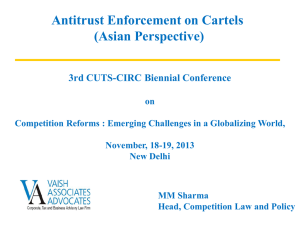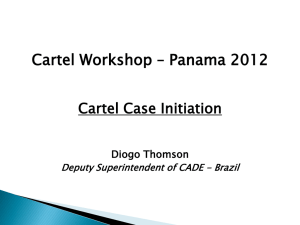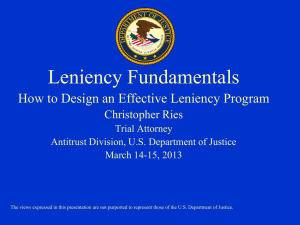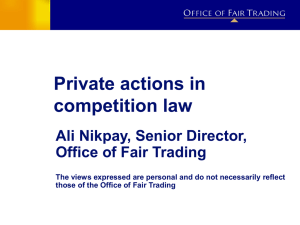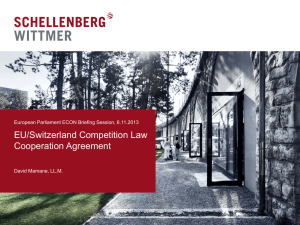TD United Nations Conference on Trade and Development United Nations
advertisement
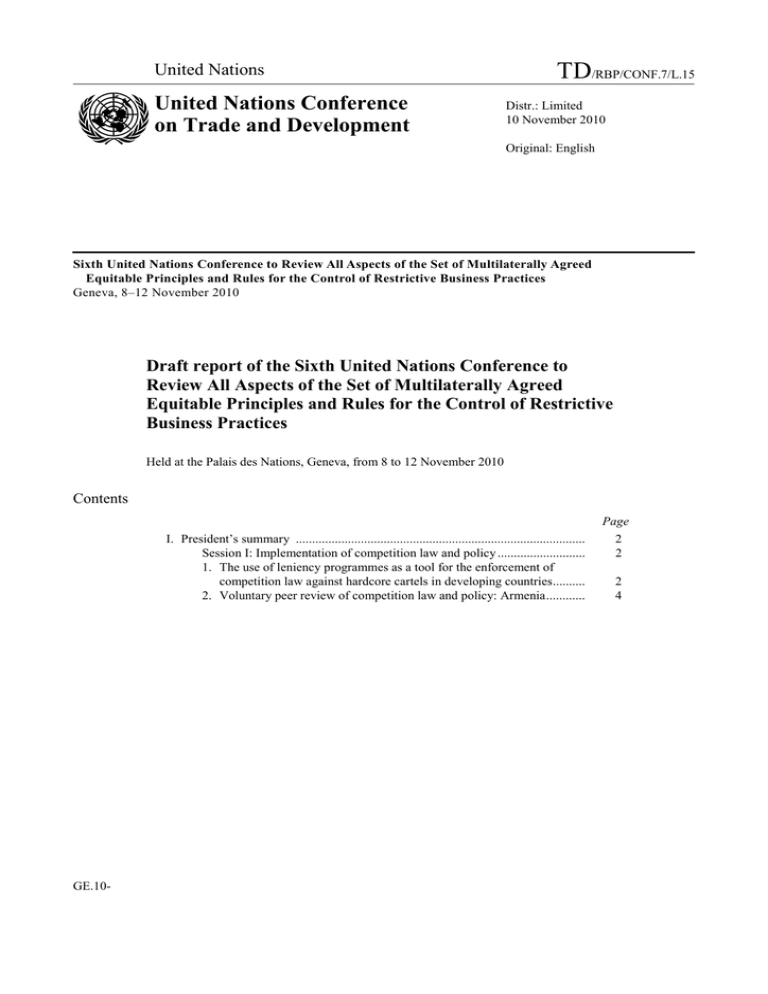
United Nations United Nations Conference on Trade and Development TD/RBP/CONF.7/L.15 Distr.: Limited 10 November 2010 Original: English Sixth United Nations Conference to Review All Aspects of the Set of Multilaterally Agreed Equitable Principles and Rules for the Control of Restrictive Business Practices Geneva, 8–12 November 2010 Draft report of the Sixth United Nations Conference to Review All Aspects of the Set of Multilaterally Agreed Equitable Principles and Rules for the Control of Restrictive Business Practices Held at the Palais des Nations, Geneva, from 8 to 12 November 2010 Contents Page I. President’s summary ......................................................................................... Session I: Implementation of competition law and policy ........................... 1. The use of leniency programmes as a tool for the enforcement of competition law against hardcore cartels in developing countries.......... 2. Voluntary peer review of competition law and policy: Armenia............ GE.10- 2 2 2 4 TD/RBP/CONF.7/L.15 I. President’s summary Session I: Implementation of competition law and policy 1. The use of leniency programmes as a tool for the enforcement of competition law against hardcore cartels in developing countries 1. Mr. Fernando de Magalhães Furlan, Commissioner and Acting Chair of Conselho de Defesa Econômica (CADE)/Brazil, delivered the keynote speech. Mr. Theodor Thanner, Chair of the Bundeswettbewerbsbehörde (Federal Competition Authority)/Austria and Mr. Joseph Wilson, Member of the Competition Commission of Pakistan, contributed as panellists to the round table discussion. 2. The UNCTAD secretariat gave a brief presentation setting out the main findings of the secretariat’s background paper on leniency in developing countries (TD/RBP/CONF.7/4). It was reported that leniency programmes had proven to be a very powerful tool for cartel detection in well-established competition law regimes, whereas only a small number of younger competition law regimes from developing countries had adopted such programmes. Against that background, the background paper of the secretariat raised the question of whether leniency programmes had the potential of serving as an effective tool for fighting cartels in developing countries. In order to answer that question, conditions for successful leniency programmes in well-established competition law regimes, as well as existing challenges in those countries, were assessed. The paper continued by asking whether specific conditions in developing countries impacted on the potential success of leniency programmes in those countries. It concluded that the main challenge for young competition authorities was to establish a credible enforcement threat. Without a high risk of cartel detection and prosecution leading to deterrent fines, cartel members would not have an incentive to self-report to a competition authority and give up cartel profits. 3. The panellist from Brazil shared his country’s experience with leniency as a tool for fighting cartels. Leniency agreements were introduced in the Brazilian legal system in 2000, a year before the Brazilian legislature adopted a similar clemency agreement in criminal cases for the first time in Brazilian legal history. The panellist from Brazil noted that there were certain necessary prerequisites for an efficient leniency programme: (a) predictability of procedures; (b) protection of lenient identity and data; and (c) high risk of cartel detection and punishment. The third of those prerequisites was particularly emphasized. In Brazil, investigators focused their efforts on fighting cartels and had increased the number of dawn raids and temporary imprisonment between 2003 and 2007. With regard to deterrent punishment for cartel membership, Brazil noted that it had increased its sanctions since the introduction of its leniency programme. The average of the top fines imposed by CADE in 2003 for cartel cases was close to 1 per cent of the total turnover of companies involved, whereas in 2010 CADE imposed a fine corresponding to 25 per cent of the turnover of a member of Brazil’s “Oxygen Cartel”. Furthermore, in 2003, there was no temporary imprisonment related to cartel cases, compared to 30 in 2007. The keynote speaker continued by presenting the Brazilian concept of “cease agreements”. Since its creation in 1994, the Brazilian competition law also prescribed the possibility for a defendant in a cartel case to propose a so-called “cease agreement” under mandatory conditions. Therefore, a “second in line” in a leniency agreement, for instance, would still have the possibility to benefit from lenient treatment. 2 TD/RBP/CONF.7/L.15 4. The panellist from Austria gave an explanation of the legal framework for leniency in Austria. The Austrian leniency regime entered into force in 2006 and was adapted to the structure of the Austrian enforcement system, an institutional dichotomy with separation between investigative and decisional powers. In Austria, the Federal Competition Authority acted as the investigative body in case of competition law infringements, whereas decisionmaking power was vested in the Cartel Court (and Supreme Cartel Court). The application of the leniency programme rested solely with the competition authority. The scope of the Austrian leniency programme covered more than only secret horizontal collusion. It also applied to vertical agreements and non-secret agreements. As to its conditions, it was explained that the threshold for immunity would be low: (a) the applicant needed to be the first to report the cartel; and (b) the competition authority must not have been aware of the anticompetitive practice before the application. No evidential threshold was foreseen under the Austrian leniency regime, although the applicant had to submit all evidence in its possession under its duty to cooperate. Austria’s advocacy efforts had made the Austrian leniency programme more effective. It was the introduction and advocacy of the leniency system that helped to establish a culture of competition in Austria. 5. The panellist from Pakistan gave an overview of the inception of its competition legislation and the framework for its enforcement. Owing to the temporary and ephemeral nature of the initial competition ordinances, it was difficult to build a competition culture in Pakistan. In 2010, competition legislation was enacted giving more permanency to the competition regime. The leniency programme was developed to fill the periodic lapses in the competition law legalisation. In Pakistan, the leniency programme was outlined in Section 39 of the legislation. The section provided the legal basis for leniency and was applicable to prohibited agreements, i.e. cartels. Discretion was granted to the Commission, which should pay regard to the stage at which the party came forward and the type of information that was provided. To obtain leniency, the enterprise had to end its participation in the cartel. In the event on non-compliance, leniency could be revoked. 6. In the subsequent discussion involving speakers from the floor, the delegate from Zambia reported that the country did not have an established leniency programme. However, cartels were punished by levying fines of up to $2 million and by criminalizing cartelizing conduct. Given the potential application of criminal punishments, there was a need to adduce proof beyond a reasonable doubt to meet the criminal standard. A leniency programme was a significant element of the new legislation passed in 2010. The delegate from Zambia noted that the Brazilian experience served as a relevant demonstration that, unless the leniency programme was backed by serious deterrence and the necessary resources to investigate and prosecute companies engaged in cartel conduct, companies would not avail themselves of a leniency programme. 7. A private legal practitioner delegate from the EU shared the perspective of companies that had to decide whether to apply for leniency in a particular jurisdiction, and what considerations prevailed when a member of a cartel had to submit multiple applications. The focus of this intervention was on the benefits afforded to a company by a leniency regime. It was noted that companies were highly incentivized to mitigate fines. It was noted that, as long as a leniency regime contained certain key aspects, companies would queue to take advantage of the benefits of leniency. The key aspects of a leniency regime were identified as (a) the clear identification of benefits; (b) whether employees of the applicant were made immune from criminal prosecution; (c) the nature and extent of information the applicant had to provide; (d) procedures that were transparent and predictable; and (e) a track record that showed that other enterprises found the leniency programme predicable and beneficial. 8. It was also pointed out that, for a leniency programme to be successful, a “marker system” was necessary and that the prospect for withdrawal of the leniency application 3 TD/RBP/CONF.7/L.15 should be rare and difficult, and the threshold for attaining for leniency should be low. It was also noted that competition authorities should seek to harmonize their leniency regime with each other as this was a key consideration for many applicants contemplating application for leniency. 9. A number of countries intervened and delivered contributions from the floor. The focus of those contributions highlighted three key points. First, there was a concern as to whether simultaneous application for leniency by two or more cartel participants could be addressed by the legislation. This was a point raised by both India and Tunisia. The response to this question, delivered by consensus among Brazil, Austria and the European Union, was that a regime that granted leniency to the first company and then via a system of pro-rated fine reductions to those that come later had proven to be a workable system. 10. The second issue highlighted was that a leniency regime had to be complemented by (a) strong deterrence tools such as high fines or the possibility for criminal sanctions for those engaged in the cartel conduct; and (ii) confidentiality in proceedings that led up to the negotiation and ultimate achievement of a leniency agreement. In connection with the latter point, it was noted that immunity from civil action was not a benefit in respect of most leniency regimes around the world. Therefore, no immunity is afforded against actions for damages in a civil suit and that companies understood that they would have to defend themselves against civil action if they undertook an application for leniency. 11. The third issue highlighted was whether the leniency regime had to be included in the competition legislation or whether it could be outlined in subsidiary rules. This was a concern that was raised by Uganda. A number of countries – including Brazil, Pakistan and Austria – noted that the leniency programme was a feature of substantive legislative provisions in their countries and featured as part of the competition law or other complementary legislation. It was noted, however, that whatever legal framework adopted to implement the regime, there was a need for wide-scale advocacy of the leniency regime. Austria noted that the advocacy of the leniency regime was a good way to build a culture of competition within the business community. 12. It appeared to be the consensus among the panellist countries of Brazil, Austria and Pakistan that a leniency regime was the best way to enforce competition law and combat cartelizing conduct in the absence of the necessary human and financial resources to do so. It was noted that, for developing countries now adopting competition legislation, the adoption of a leniency regime could resolve the issue of lack of resources to investigate and enforce against cartelising conduct. 2. Voluntary peer review of competition law and policy: Armenia 13. The voluntary peer review of competition law and policy in Armenia was chaired by Mr. Bruno Lasserre, President of the French competition authority. The peer reviewers were Mr. Markus Lange, Head of the International Relations Department of the German Competition Authority; Mr. Jozsef Sarai, Head of the International Relations Department of the Hungarian Competition Authority; Ms. Anna Maria Tri Anggraini, Indonesia, ViceChair of the Indonesian Competition Authority; and Mr. Andrey Tsyganov, Deputy Head of the Russian Federation Competition Authority. The Armenian delegation was co-headed by Mr. Nerses Yeritsyan, Minister of Economy of the Republic of Armenia, and Mr. Artak Shaboyan, Chair of the State Commission for the Protection of Economic Competition of the Republic of Armenia. It comprised staff members of the State Commission for the Protection of Economic Competition (SCPEC), the Ministry of Economy as well as representatives from the administrative court. 14. After introductory remarks by the Secretary-General, the first session of the peer review started with a presentation of the main findings of the report “Voluntary peer review 4 TD/RBP/CONF.7/L.15 of competition policy: Armenia” (UNCTAD/DITC/CLP/2010/1) by Mr. William Kovacic (Untied States) and Mr. David Lewis (South Africa), consultants for UNCTAD. The presentation covered (a) the foundations and history of competition policy in Armenia including the historical, political and economic context; (b) the legal framework; (c) institutional aspects of competition law enforcement in Armenia, including possible adjustments to competition policy enforcement structures and practices; and (d) the main findings and recommendations. 15. The consultants emphasized two fundamental facts of Armenia’s political and economic life, which have a direct and powerful impact on the country’s competition law and policy: (a) Armenia’s status as an economy in transition that was until recently a centrally planned economy within the Soviet Union; and (b) the geopolitical situation in the South Caucasus. Those factors would be reflected in the performance of the Armenian economy, the structure of the Armenian economy, Armenia’s ability to trade with rest of world and distortions of its trading patterns, an interpenetration of private economic property relations and public life and institutions, the size of the so-called “shadow economy” and the size and the loyalty of the Armenian Diaspora. The presenters also gave a short overview on Armenia’s post-Soviet transition towards a market economy, including the privatization process carried out after the breakup of the Soviet Union. Regarding the present economic and political situation, it was pointed out that important markets in Armenia were characterized by high levels of concentration (e.g. sugar, rice, grains and fuel markets), which were also influenced by limited points of entry and exit for traded goods. Particular emphasis was given to the phenomenon of the so-called “shadow economy”, which consists in a significant underreporting of trade and sales volumes by formal market players in order to evade taxes and import duties. This underreporting led to a significant underestimation of the entire size of Armenia’s economy, and gave dominant incumbents a massive competitive advantage over potential new entrants and thereby deters new entry. 16. With respect to the establishment of the Armenian competition law system, the consultants reported that “free economic competition” was constitutionally guaranteed in Armenia and that the Armenian criminal code sanctioned certain forms of anticompetitive conduct. In 2000, the Law of the Republic of Armenia on Protection of Economic Competition was passed and, in 2001, the SCPEC was established. The consultants reported that Armenian competition law covered: (a) anticompetitive horizontal and vertical agreements; (b) the abuse of dominance/monopolistic practices; (c) concentration (mergers); (d) unfair competition; and (e) State aid. It further set out the SCPEC’s objectives and functions, its powers and its composition, as well as possible sanctions and remedies for competition law breaches. 17. The presenters highlighted several areas for improving the legislative framework, i.e. the formulation of the prohibition of anticompetitive agreements, the definition of dominance, the obligation to maintain a register for dominant companies, revision of the merger control regime and State aid provisions. The most important deficiency of the current legislative framework related to the investigation powers of the SCPEC, which were clearly judged as insufficient to perform the SCPEC’s functions. In that context, it was also emphasized that the budgetary situation of the SCPEC was disastrous and needed significant improvement. The presentation was terminated by an explanation of the main recommendations addressed to the legislature, to the Government and to the SCPEC. 18. In his observation on the peer review report, the Armenian Minister for the Economy emphasized that competition law and policy needed to be assessed in the context of broader reforms in Armenia. He pointed out that the recent economic crisis had shown the strengths and weaknesses of the Armenian economy and the need for a number of reforms, including many concerning competition law and policy. It was further emphasized that the role of the State in the Armenian economy was very limited. Approximately 80 per 5 TD/RBP/CONF.7/L.15 cent of the country’s businesses were privately owned and employment by private firms also amounted to 80 per cent. The minister highlighted that Armenia had already started legislative reforms of its competition law regime with support from the World Bank. Consequently, some of the recommendations of the peer review report would soon be implemented. 19. The comments by the Armenian Minister for the Economy were followed by observations by the Chair of the competition authority, who reported that the SCPEC had recently elaborated a comprehensive three-year strategy paper. In addition to strategic goals, this paper would set out a timetable for specified activities and resources that were needed for their implementation. Importantly, the Government had already approved the legislative amendments that were necessary in order to implement the recommendations by the peer review report and currently, the proposals were presented to the Armenian Parliament. 20. These observations by the Armenian delegation were followed by a question-andanswer session. Questions raised by panellists broadly fell into the following categories: (a) questions relating to the economic and political context of Armenia’s competition law regime; (b) questions relating to specific aspects of Armenia’s competition law system; (c) questions relating to powers of the SCPEC; (d) questions relating to the national and international cooperation of the SCPEC; and (e) questions relating to overall strategy and achievements of the SCPEC. 21. In the second session, Armenia was given the opportunity to ask specific questions of other competition authorities, with a view to benefit from the experience of other competition authorities. The first question raised by Armenia was how its competition authority could measure its performance and effectiveness. The suggestion was made by the United States that Armenia could consider articulating a strategy that expressed the SCPEC’s goals and which clearly engaged in public debate and addressed the soundness of the competition authority’s programme. A specific mechanism could be put in place to measure effects of the authority, for example, by keeping careful track of what each project was expected to accomplish, and by working with the university community, nongovernment advisors and think tanks to measure effects. Finally, a suggestion was made to trace, over time, how specific initiatives helped Armenia attract more foreign investment. The second question posed by Armenia concerned how dominance was defined in other countries, which was answered by Germany. Owing to the limitations in timing for the session, it was decided that further questions by the SCPEC would be published on the UNCTAD secretariat’s website and delegates were invited to share their experience and knowledge in this regard with the SCPEC. 22. In the third session, the UNCTAD secretariat presented a technical assistance project to address the report’s findings and recommendations. The secretariat noted that it had prepared certain technical assistance activities to address the recommendations of the peer review and that those activities were designed to complement the existing cooperative efforts between Armenia and other international organizations that currently supported Armenia’s competition regime including the German Organization for Technical Cooperation (GTZ), the Organization for Security and Cooperation with Europe (OSCE) and the World Bank. The secretariat noted Armenia’s strategic plan for the next three years to (a) amend its legislation; (b) engage in capacity-building and advocacy of its competition law and policy; (c) encourage efforts of resource management and (d) seek out modalities for international cooperation. The floor was given to Armenia’s current development partners, who also outlined their future role as regards technical support. 23. GTZ noted that Germany had an interest in cooperating with Armenia as it was Armenia’s biggest trading partner amongst EU member States. GTZ would prioritize capacity-building, advocacy, and training of experts; and would engage in efforts to 6 TD/RBP/CONF.7/L.15 increase the number of experts in the SCPEC. OSCE gave an overview of its broad engagement in Armenia, which also covered the area of competition law and policy. It would continue to be involved in the promotion of the rule of law and the promotion of programmes to build the competence of judges. OSCE noted that the link between the rule of law and fair competition could not be overstated. A memorandum of understanding had been signed recently, which finalized the mechanisms by which support would be provided to the SCPEC. The SCPEC would be given a system to measure the effectiveness of its enforcement measures. 24. A consultant engaged by the World Bank noted that the World Bank’s work in this area started with a general report and assessment of the economic circumstances in Armenia. The report was issued in the middle of 2009 and largely identified the problems outlined and the solutions proposed in the peer review. Accordingly, the World Bank’s efforts would be focused on refining legislation and guidelines that were most likley to work in Armenian economic and social environment. 7
